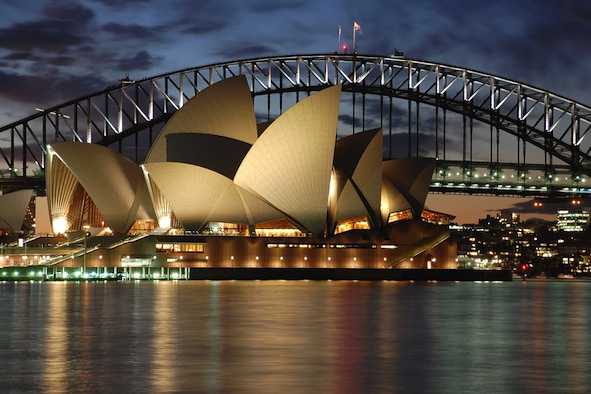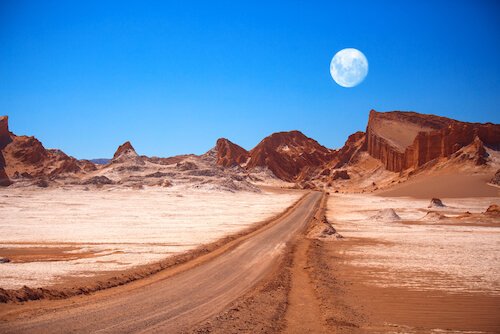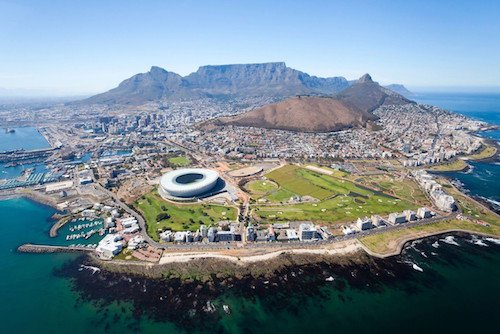Southern Ocean Facts for Kids
Top Ten Facts about the Southern Ocean
Here are our Top Ten Southern Ocean Facts for Kids with lots of useful info for school projects or to get inspired for your next travels. Read here what you definitely should know about the Southern Ocean.
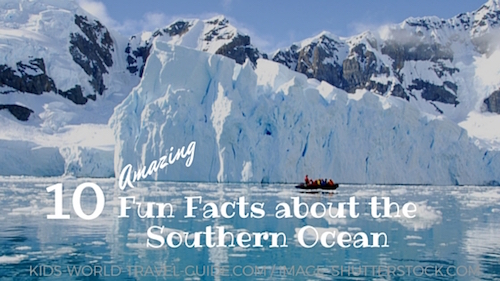
1. Location: Where is the Southern Ocean? The Southern Ocean is located in the southern hemisphere, south of 60 degrees South latitude. It surrounds Antarctica. The Southern Ocean is thus 'emerging' from the waters of the South Atlantic Ocean, the South Pacific Ocean and the Indian Ocean in latitudes south of 60 degrees South. Below you can see a map showing Antarctica and the Southern Ocean surrounding it:
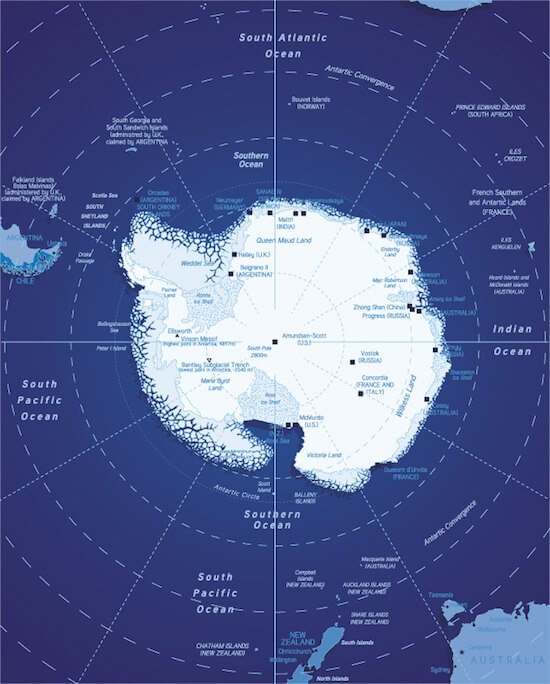 Southern Ocean Map
Southern Ocean Map2. Name: The Southern Ocean is also referred to as the Antarctic Ocean, South Polar Ocean or Austral Ocean. The Southern Ocean is the youngest ocean as it was formed 'only' 30 million years ago when South America and Antarctica moved apart.
3. Size: How big is the Southern Ocean? The Southern Ocean is the fourth biggest (or second smallest) ocean on earth and covers only 6% of the earth’s surface.
4. Depth: How deep is the Southern Ocean? The Southern is between 4,000m and 4,800m/12,000ft and 14,000ft deep with some deep trenches. The average depth is about 3,200m/10,700ft. The deepest point in the Southern Ocean is in the South Sandwich Trench with a depth of over 7,000m 23,000ft!
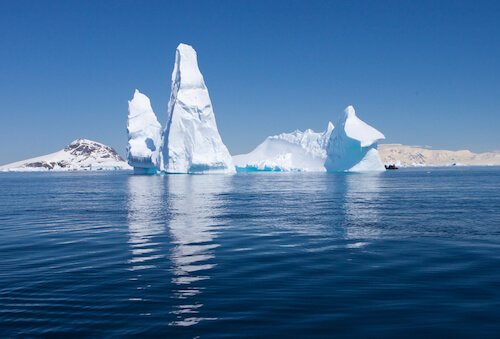 Iceberg in the Southern Ocean
Iceberg in the Southern Ocean5. Southern Ocean Facts: Icebergs will be encountered in the Southern Ocean during any season, but during May to October there are also strong winds which make crossing the ocean even more dangerous. Big iceberg fragments (huge junks of ice) drift in the water. They can big several hundred metres high! Ice fragments are considered small if they are not thicker than 1m/3ft. Still even in summer ice-breaker ships often need to escort ships on their passage through the Antarctic waters.
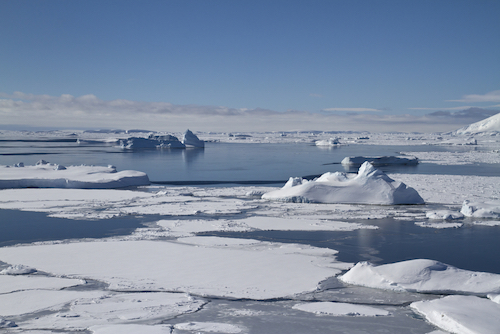 Icy waters of the Southern Ocean
Icy waters of the Southern OceanMore Southern Ocean Facts
6. Temperature: The sea temperatures of the Southern Ocean range from -2 deg Celsius to 10 degrees Celsius/28F - 50F. The climatic conditions depend also on the seasons. Winter is long and lasts from April to October. Then the water temperature will in general be below 0 degrees Celsius/32 Fahrenheit. The water in the Southern Pacific Ocean freezes in winter below 65 degrees South latitude while in the Southern Atlantic Ocean, the water freezes already below 55 degrees South latitude! The Antarctic coastline has, however, also some few ice-free areas, even in winter.
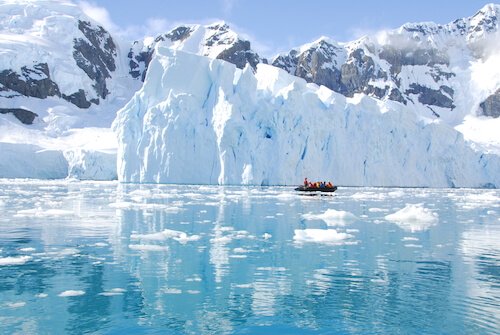 Exploring Antarctica
Exploring AntarcticaThe low temperatures in the region, however, do not deter tourists exploring the area on special adventure travels and expeditions. More than 50,000 tourists experience the Southern Ocean every year.
7. A bit of history on the Antactic Ocean and Antarctica: The first known explorers who came in contact with the cold waters of the Southern Ocean were Bartolomeo Diaz who circumnavigated the Cape of Good Hope in South Africa in 1487 and Ferdinand Magellan who explored the Tierra del Fuego in South America in 1520. Captain James Cook searched for land in the Southern Ocean but never sighted Antarctica, he landed in Botany Bay/Australia in 1770 instead. He, however, crossed the Antarctic circle and reached as far as 71 degrees South latitude in 1773.
In 1819, for the first time land was sighted south of 60 degrees South latitude. Only in the 19th century Antarctica was discovered and explored during various expeditions. Sir Ernest Shakelton's expedition was the first attempt to cross Antarctica on land, but they only managed to reach 88 degrees South latitude. Roald Amundsen was the first to reach the South Pole in 1911.
8. Southern Ocean Facts: Animals in the Southern Ocean. The Southern Ocean is home to the emperor penguins and wandering albatrosses, blue whales and fur seals. Some seal species hunt underwater and breed on land or on ice. The biggest of the seals are the elephant seals which weigh up to 4,000kg/8,818lb. Every spring over 100 million birds nest on the rocky shores of Antarctica.
There are also several species of invertebrates living in the Southern Ocean, but only few species of fish. The largest invertebrate found on our planet is the giant squid, which lives in the Southern Ocean. It grows up to 15m/49ft in length!
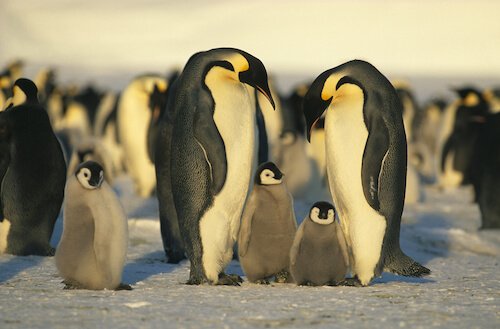 Emperor Penguins with their chicks
Emperor Penguins with their chicks9. Ports: There are only a few ports in the Southern Ocean. The ports belong mainly to research stations, such as the Rothera Station (British research base), Palmer Station (USA), Mawson Station (Australia), but the southernmost ports in Australia are recognised also as ports of the Southern Ocean. Among them are Adelaide port in South Australia and Macquarie Port on Tasmania. The southernmost port in the Southern Ocean is McMurdo Station, which is an American research base, built on Antarctic land claimed by New Zealand. Access to the ports is limited only to summertime and even then ice-breakers often need to escort visiting ships.
10. Southern Ocean Facts: Do people live permanently on Antarctica? There are no indigenous people on Antarctica. On the coldest continent there are only research stations from various countries, but these researchers, scientists and explorers and their families work and live there only for a limited time.
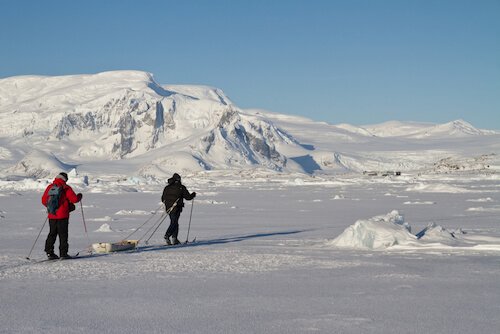 Researchers working on Antarctica
Researchers working on AntarcticaThere are only two settlements on Antarctica, where there are people living and working all year round. These settlements are small, with less than 100 people in winter. They are the Chilean research station 'Villas Las Estrellas' and the Argentinian research station 'Esperanza Base'. The temperatures there are very cold, between 0 degrees Celsius and -10 degrees Celsius. However, climate change is noticeable also there, as in March 2015, the highest temperature recorded was 17 degC/62F!
Southern Ocean Facts: Did you know that several big yacht races are held also in the Southern Ocean, among the most well-known are the Volvo Ocean Race and the Global Challenge?
Southern Ocean Facts
Great Resources
- Read more on the Southern Ocean in the CIA World Fact Book
- Read more about the amazing Volvo Ocean Race (the next race will be held in 2017) here
- Great short video (3mins) by National Geographic about 'Exploring Antarctica'
Picture Credits for Southern Ocean Facts Page: Shutterstock.com
Back from Southern Ocean Facts to General Ocean Facts for Kids
Return from Southern Ocean Facts to Kids-World-Travel-Guide Homepage

***
Did you like what you read?

|
Share this article with your family, friends and students. Simply copy and past this text: <a href="https://www.kids-world-travel-guide.com/southern-ocean-facts.html">Kids World Travel Guide: Southern Ocean Facts for Kids</a> Thank You for spreading the word:-) |

